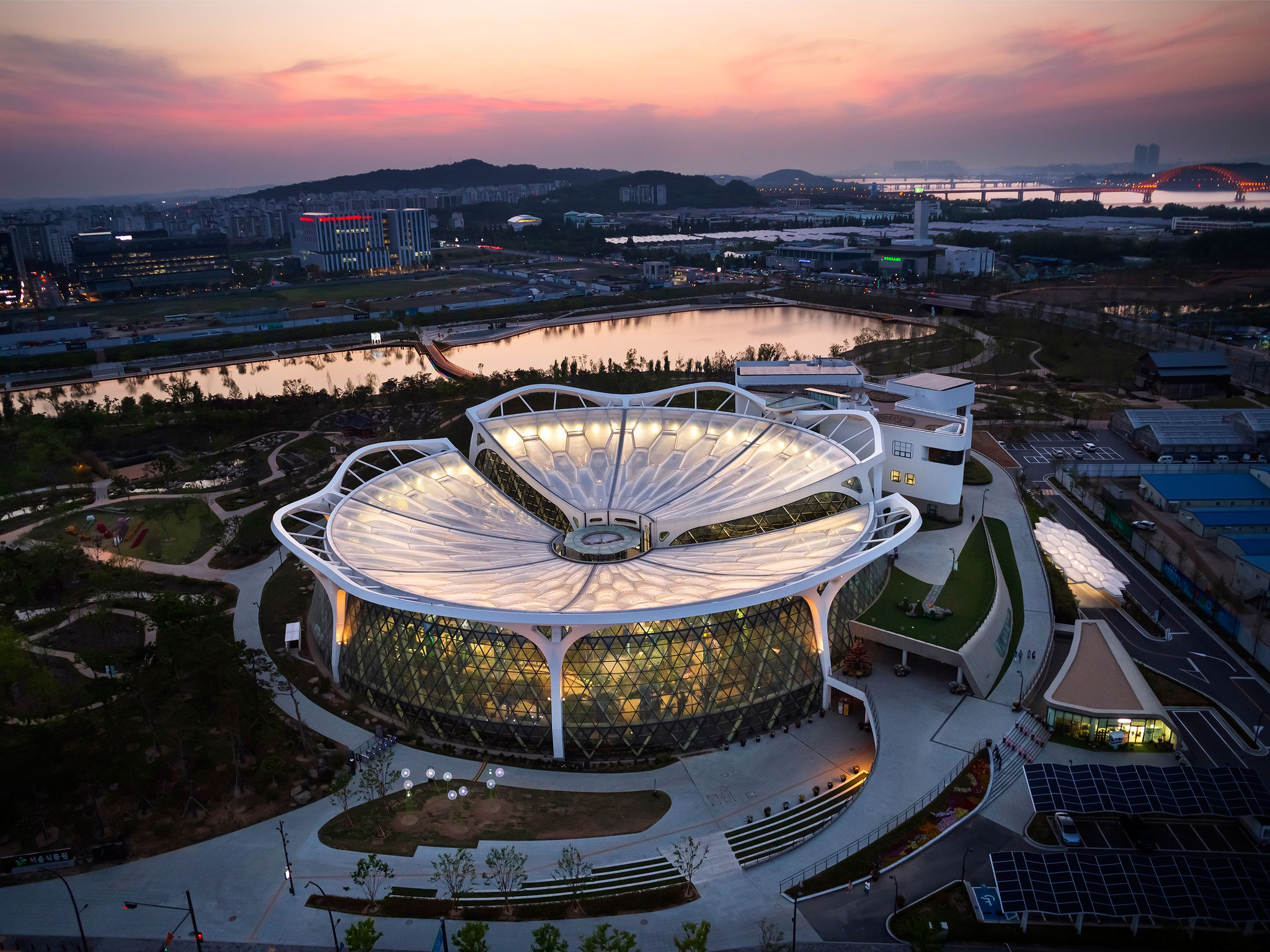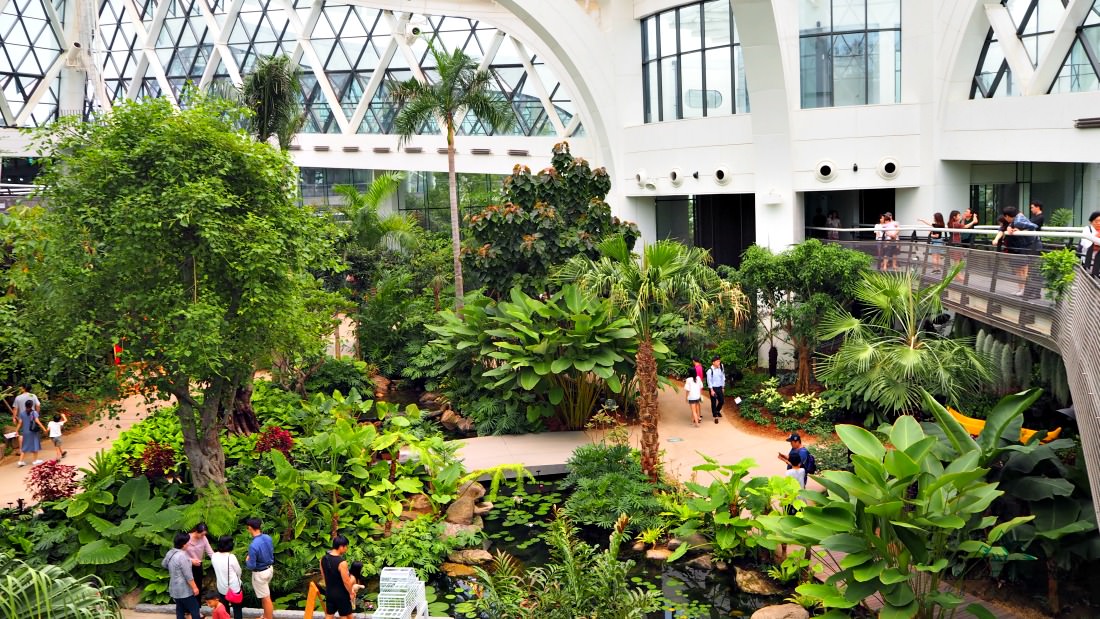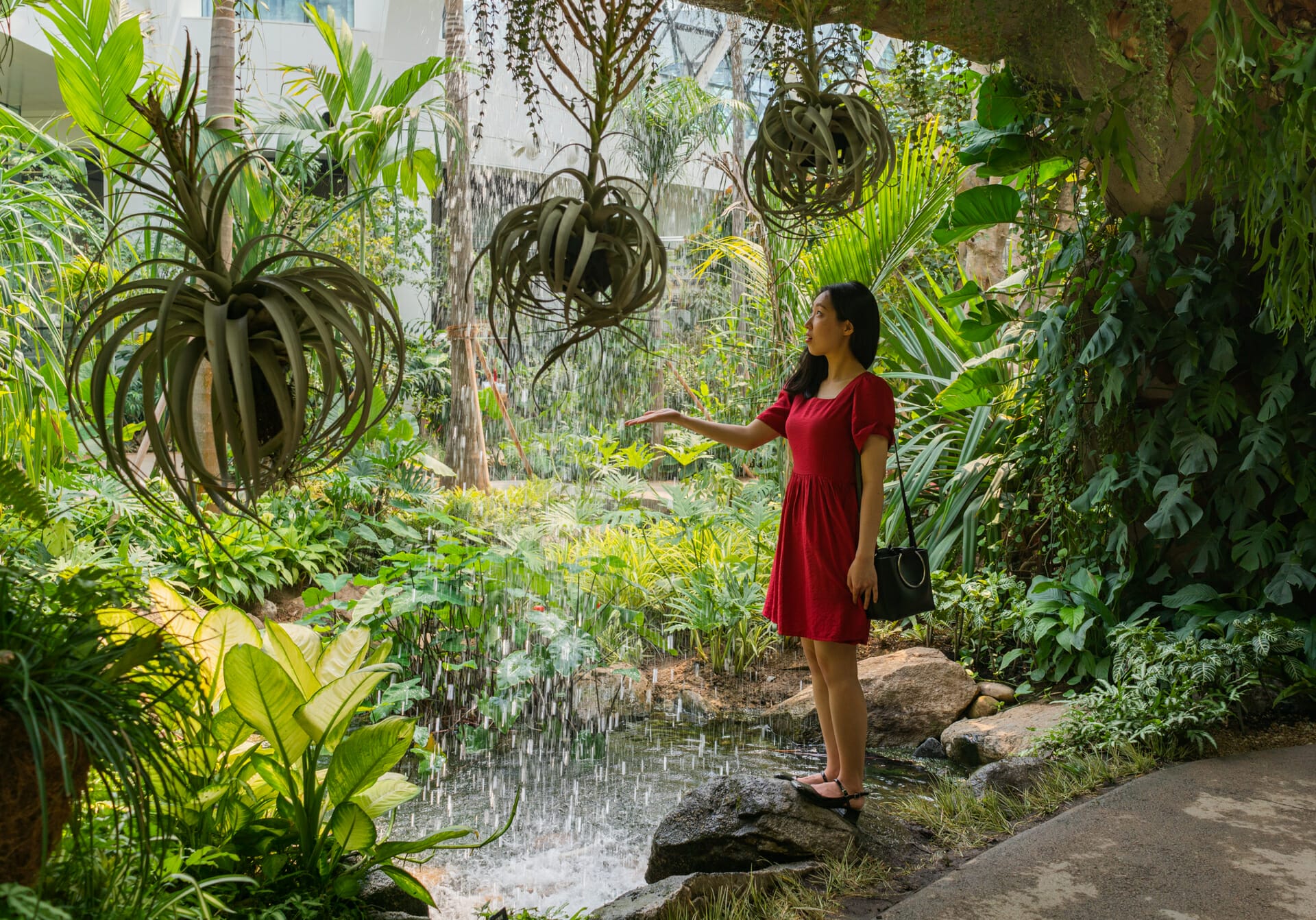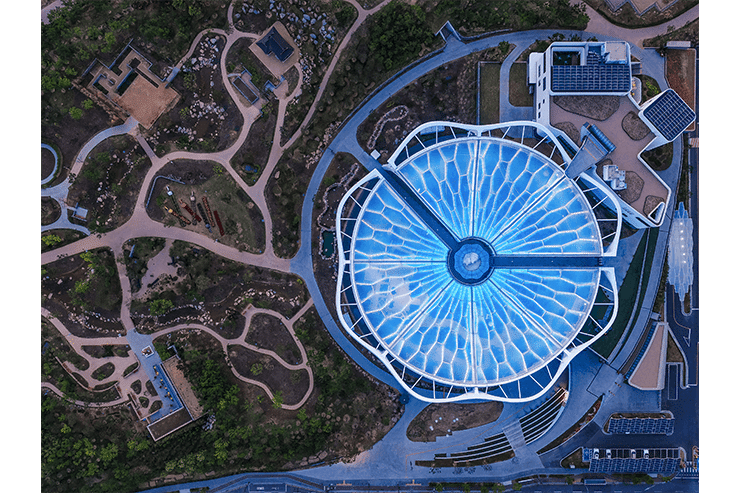Urban parks play a vital role in city living, providing sanctuary from the concrete jungle and enriching the quality of life (Chiesura, 2004). Botanic gardens are a special type of urban green space, showcasing diverse plant collections for recreation, education, scientific study, and conservation (BGCI, 2022). As South Korea’s first and largest botanic garden, Seoul Botanic Park is an iconic landmark bringing nature to the heart of the bustling capital (Lee, 2017). This paper comprehensively reviews Seoul Botanic Park, exploring its history, layout, facilities, programs, environmental initiatives, and significance.
Seoul Botanic Park occupies an expansive 199 acres in the northern Seongbuk district, nestled against the slopes of Bugaksan Mountain (Kim, 2010). Since opening in 1946, it has grown to house over 10,000 plant species across multiple themed gardens linked by landscaped walking trails (Seoul Botanic Park, 2022). The park provides an urban oasis for locals and tourists to enjoy horticultural displays, scenic nature, and educational experiences. As the nation’s premier botanic garden, it contributes to conservation, research, and public education (Korea Botanic Garden, 2022).
This paper examines Seoul Botanic Park’s origins, transformation, and mission. The key attractions, layout, and facilities are overviewed. The diverse gardens, architecture, and amenities are surveyed as visitor highlights. The park’s multifaceted recreational, cultural, scientific, and educational roles are explored. Finally, a vision for the future is presented based on sustainable development and community-building goals.
History and Development
The origins of Seoul Botanic Park date back to the early 20th-century Japanese occupation, when an imperial botanical garden was established by Tokyo University in 1922 (Kim, 2010). Covering 333,660 pyeong (110 hectares), it contained over 4,300 plant species collected across Korea, Japan, and China. However, the garden was later requisitioned by the United States military post-World War II and fell into neglect (Seoul Botanic Park, 2022).
In 1946, the Seoul City Government designated 182,000 pyeong of the remaining land as Seoul Botanic Park (Lee, 2017). The park was established through considerable citizen donations and volunteer efforts to transform it from an abandoned military site into a new public green space. The grand opening ceremony was held on October 10, 1946 presided over by President Syngman Rhee. In the 1950s-60s, facilities like the Botanic Garden Library and Herbarium were constructed. Over the next decades, the park continued expanding with a rose garden, conservatory, and bonsai garden.
Major modernization ensued in 2002 for the Korea-Japan World Cup as the park was upgraded into a world-class botanical cultural space (Kim, 2010). The old imperial Japanese landmarks gave way to contemporary Korean architecture styled after traditional palaces and temples. Key new additions included the glasshouse complex, lotus pond, Korean Garden, and Nature Gift Shop. The eco-museum was also inaugurated, containing exhibits on nature and botanical art. The park underwent further renovation for its 60th anniversary in 2006 to improve accessibility.
Today, Seoul Botanic Park covers 199 acres, containing over 10,000 plant types belonging to 3,000 species from Korea and around the world (Seoul Botanic Park, 2022). As the nation’s flagship botanic garden, it continues efforts to expand and enhance its living collections and facilities. The park now incorporates advanced educational, recreational, and technological functions, befitting a 21st-century global botanic garden.
Layout and Gardens

Seoul Botanic Park is divided into a network of indoor and outdoor gardens, each with different themes and horticultural collections. Visitors can explore 14 major gardens and over 20 specialized exhibition houses (Lee, 2017). The major gardens include:
Main Gardens – The park’s central zone contains diverse flowers, trees, and lawns for leisure. It leads to the lotus pond and tropical palms area.
Botanic Garden – Showcases 2,000 plant species organized by family for scientific study. Specimens are labeled, providing botanical information.
Korean Garden – Features native Korean plants surrounding traditional pavilions, sculptures, and ponds based on Joseon-era royal palace gardens.
Bonsai Garden – Exhibits miniature potted trees and rock plants from Korea and abroad, some over 80 years old.
Herb Garden – Displays 500 types of medicinal plants used in Oriental medicine.
Horticultural Therapy Garden – Specially designed for the disabled, elderly, and children, featuring tactile, aromatic, and colorful plants.
Rose Garden – Home to 150 rose varieties like hybrid teas, floribundas, grandifloras, and old garden roses. The roses bloom from May to October.
Children’s Garden – Provides kids a space to learn about plants through interactive exhibits and hands-on gardening.
Arboretum – Collects woody plants like conifers and magnolias across 50 acres adjacent to the Korea National Arboretum.
Wetlands Ecosystem Gallery – Mimics a wetlands environment with aquatic plants, birds, insects, and wildlife.
The grounds also contain diverse exhibition houses such as the Cactus House, Orchid House, Lotus Pond, and four climate-controlled glasshouses displaying tropical, subtropical, and desert species. The Desert House features a soaring 50-foot-tall cactus collection. Spacious lawns, ponds, streams, wooded trails, and architecture link the diverse gardens and greenery.
Attractions and Facilities

Beyond the extensive botanical collections, Seoul Botanic Park offers many recreational and cultural attractions. Visitors can stroll through traditional Korean gardens, admire exotic orchids and cacti, gaze at lotus blossoms, or relax amid roses and herbs. For families, the Children’s Garden has interactive exhibits and play areas. The park also contains architectural landmarks like the old Japanese-built Lotus Pond and the Korean-style Entrance Gate.
The on-site amenities provide further attractions. The Botanic Garden Library and Herbarium are research centers housing over 10,000 academic volumes and 300,000 botanical specimens (Seoul Botanic Park, 2022). The Botanical Art and Crafts Gallery showcases plant-themed artwork and handicrafts. The park has an Ecology Museum with nature exhibits and an IMAX theater screening botanical documentaries. Visitors can shop at the Nature Gift Store for botanical souvenirs.
The Sky Garden Restaurant offers scenic views from its hilltop perch for dining. The park also has casual cafes and refreshment kiosks. Additional facilities include an outdoor performance stage, lakeside pavilion, photography garden, and garden-view cottages. The multipurpose Mongchon Hall hosts exhibitions, events, weddings, and corporate retreats with full A/V capabilities. There are also zones for culture/education and administration/research, demonstrating the park’s comprehensive amenities.
Roles and Programming

As South Korea’s flagship botanic garden, Seoul Botanic Park serves various roles for the public:
Recreational Role
With its beautiful scenery, floral displays, and spacious lawns, the park provides an idyllic recreation spot for urbanites to relax and rejuvenate. Visitors can picnic, walk dogs, exercise, attend concerts, dine at restaurants, or photograph nature. The park offers respite from city crowds and concrete, enriching the quality of life.
Cultural Role
The park celebrates Korea’s horticultural heritage and diverse plant life across its themed gardens. Traditional Korean landscapes evoke history and culture. Events like botanical festivals, art exhibits, and craft fairs promote cultural appreciation. The park is also a prized architectural asset with Korean-style pavilions.
Scientific Role
The park supports the preservation, research, and display of plant diversity. Its living collections are a botanical library for studying plant taxonomy, morphology, and ecology. The herbarium and laboratory facilitate research. The park collaborates with universities, museums, and associations on academic projects.
Educational Role
With guided tours, specialized programs, and informative displays, the park provides a hands-on educational experience about plants and nature for all ages. The Children’s Garden, Ecology Museum, and IMAX theater make learning interactive.
Environmental Role
As an urban green space, the park positively impacts Seoul’s environment. Its trees improve air quality, reduce noise pollution, and provide animal habitat. The wetlands gallery promotes ecological awareness. Sustainable practices are increasingly implemented.
The park fulfills these roles via regular public programming and events. Year-round attractions include themed exhibitions, cultural festivals, art displays, music concerts, academic lectures, and hands-on gardening classes. Seasonal programs include spring flower shows, summer water lily festivals, and winter light gardens. The park also hosts special events like weddings, corporate retreats, photography contests, and volunteer activities. Integrated commercial facilities, restaurants, and shops provide added value and amenities.
Recent Developments
Seoul Botanic Park has implemented upgrades over the past decade to enhance the visitor experience and environmental sustainability. Recent developments include:
- The new Forest of Hope was opened in 2011, containing endangered tree species and ecological wetlands.
- Constructing an eco-friendly rainwater recycling system in 2012 to sustainably water the grounds.
- Building the Mongchon Hall in 2014 as a modern multipurpose facility for conventions and events.
- Adding the fragrance Garden in 2015, enabling touch and smell experiences for the visually impaired.
- Introducing smartphone apps and QR codes in 2017, providing interactive self-guided tours.
- Certifying the Children’s Garden with a Green Flag Award in 2018 for its creative environmental education.
- Renovating the Rose Garden in 2020 with expanded varieties and accessibility features.
- Joining the International Plant Sentinel Network in 2022 to monitor for pest plant diseases.
- Launching real-time air quality indicators across the park in 2022 to promote environmental awareness.
These developments align with the park’s long-term master plan to provide world-class facilities, engaging education, universal access, and sustainable technology. Continued expansion and improvement of plant collections, amenities, accessibility, and environmental practices are envisioned.
Significance and Vision

As the first national botanical garden in South Korea, Seoul Botanic Park has held enormous symbolic and practical significance over its 75-year history. The park preserves Korean horticultural heritage and the beauty of the natural world for public enjoyment. It provides sanctuary from urbanization, recreation, culture, education, research, and ecological conservation. The park showcases Korea’s proud traditions and diverse flora through immersive landscape design.
Looking ahead, Seoul Botanic Park aims to strengthen its role as a leading global botanical garden. Key goals include expanding conservation, research, and public education initiatives. New interactive exhibits, immersive displays, and high-tech amenities can engage broader audiences. The park also plans to model best practices in environmental sustainability. Improving green transportation access and energy efficiency are priorities. Integrating green infrastructure like bioswales, green roofs, and rain gardens can demonstrate sustainable landscape management. The park will also continue cultivating its world-class plant collections, diversity of gardens, and sweeping naturalistic charm.
As an urban oasis, Seoul Botanic Park has only become more essential for reconnecting society with the natural world over time. The park provides a living museum of green treasures, where education, recreation, and inspiration intersect through the timeless marvels of the plant kingdom. Whether admiring a rare exotic orchid, strolling traditional Korean gardens, or simply relaxing under a tree, Seoul Botanic Park offers an enriching botanical experience in the city’s heart. The park’s continued evolution and growth promise a bright future as Korea’s flagship garden, serving science, culture, conservation, and the public good.
Conclusion
This paper has provided a comprehensive overview of Seoul Botanic Park – South Korea’s first and largest botanical garden located in the capital city. The iconic park has become a major recreational and cultural destination since opening in 1946, attracting over 5 million annual visitors. Key features examined include the park’s historical origins, the layout of diverse themed gardens, facilities, and attractions, multifaceted public programming, recent upgrades, and long-term vision. As both an urban oasis and a living museum, Seoul Botanic Park enriches life in the city through natural beauty, horticultural education, ecological awareness, and cultural spirit. The park has transformed from an imperial Japanese garden to a contemporary world-class botanical park promoting conservation, research, and community. Seoul Botanic Park is an invaluable green heritage site that connects people to the splendor of nature in the heart of the bustling metropolis.
Practical information about Seoul Botanic Park
- Address: Seoul Botanic Park, Seoul, Kang Seo-gu, Magokdong-ro 161
- How to get there: By subway, Airport Railroad or Line 9 Magongnaru Station, Exit 3 or Line 9, Yangcheon Hyanggyo Station, Exit 8
- Via buses 6642, 6645, 6648 Magongnaru station or buses 672, 6631, 6642, 6712 Gyeomjae Jeongseon Art Museum station
- Prices for the Botanic Garden: 5,000 won for adults (19 to 64 years old), 3,000 won for young people (13 to 18 years old), and 2,000 won for children (6 to 12 years old). Group rates can be negotiated (30 people or more).
- Opening of the Botanic Garden: March to October = 9:30 a.m. to 6 p.m. (last entry at 5 p.m.). November to February = 9:30 a.m. to 5 p.m. (last entry at 4 p.m.). Closed every Monday.
Sources: Official site of the Park | Seoul Metropolitan Government | Hallyu SG
References
BGCI. (2022). What are botanic gardens? Botanic Gardens Conservation International. https://www.bgci.org/about-us/what-are-botanic-gardens/
Chiesura, A. (2004). The role of urban parks for the sustainable city. Landscape and Urban Planning, 68(1), 129-138. https://doi.org/10.1016/j.landurbplan.2003.08.003
Kim, J. (2010, June 29). Seoul Botanic Park and changes to it. Korea.net. http://www.korea.net/NewsFocus/Travel/view?articleId=79477
Korea Botanic Garden. (2022). About the garden. South Korea Botanic Garden. http://www.kbg.go.kr/eng/about/intro.do;jsessionid=52E1B12F048FF1323526F58BF9D04C15.eng
Lee, C. (2017, October 19). Seoul Botanic Park: Beauty spot in the big city. The Korea Herald. http://www.koreaherald.com/view.php?ud=20171019000515
Seoul Botanic Park. (2022). About the garden. Seoul Botanic Park. https://botanicpark.seoul.go.kr/eng/seoul/facility1/
Did you like this article? Do not hesitate to share it on social networks and subscribe to Discover the World on Google News to not miss any articles!
